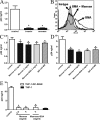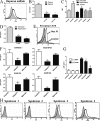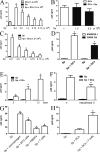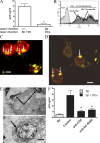Spermatozoa capture HIV-1 through heparan sulfate and efficiently transmit the virus to dendritic cells
- PMID: 19858326
- PMCID: PMC2806607
- DOI: 10.1084/jem.20091579
Spermatozoa capture HIV-1 through heparan sulfate and efficiently transmit the virus to dendritic cells
Abstract
Semen is the main vector for HIV-1 dissemination worldwide. It contains three major sources of infectious virus: free virions, infected leukocytes, and spermatozoa-associated virions. We focused on the interaction of HIV-1 with human spermatozoa and dendritic cells (DCs). We report that heparan sulfate is expressed in spermatozoa and plays an important role in the capture of HIV-1. Spermatozoa-attached virus is efficiently transmitted to DCs, macrophages, and T cells. Interaction of spermatozoa with DCs not only leads to the transmission of HIV-1 and the internalization of the spermatozoa but also results in the phenotypic maturation of DCs and the production of IL-10 but not IL-12p70. At low values of extracellular pH (approximately 6.5 pH units), similar to those found in the vaginal mucosa after sexual intercourse, the binding of HIV-1 to the spermatozoa and the consequent transmission of HIV-1 to DCs were strongly enhanced. Our observations support the notion that far from being a passive carrier, spermatozoa acting in concert with DCs might affect the early course of sexual transmission of HIV-1 infection.
Figures







Similar articles
-
The role of semen in sexual transmission of HIV: beyond a carrier for virus particles.Microbes Infect. 2011 Nov;13(12-13):977-82. doi: 10.1016/j.micinf.2011.06.005. Epub 2011 Jul 1. Microbes Infect. 2011. PMID: 21767659 Review.
-
Human seminal plasma abrogates the capture and transmission of human immunodeficiency virus type 1 to CD4+ T cells mediated by DC-SIGN.J Virol. 2007 Dec;81(24):13723-34. doi: 10.1128/JVI.01079-07. Epub 2007 Oct 3. J Virol. 2007. PMID: 17913809 Free PMC article.
-
Opposite effects of IL-10 on the ability of dendritic cells and macrophages to replicate primary CXCR4-dependent HIV-1 strains.J Immunol. 2001 Mar 15;166(6):4244-53. doi: 10.4049/jimmunol.166.6.4244. J Immunol. 2001. PMID: 11238678
-
Syndecan-3 is a dendritic cell-specific attachment receptor for HIV-1.Proc Natl Acad Sci U S A. 2007 Dec 4;104(49):19464-9. doi: 10.1073/pnas.0703747104. Epub 2007 Nov 26. Proc Natl Acad Sci U S A. 2007. PMID: 18040049 Free PMC article.
-
Viral piracy: HIV-1 targets dendritic cells for transmission.Curr HIV Res. 2006 Apr;4(2):169-76. doi: 10.2174/157016206776055020. Curr HIV Res. 2006. PMID: 16611055 Review.
Cited by
-
Role of heparan sulfate in sexually transmitted infections.Glycobiology. 2012 Nov;22(11):1402-12. doi: 10.1093/glycob/cws106. Epub 2012 Jul 6. Glycobiology. 2012. PMID: 22773448 Free PMC article. Review.
-
A possible pathogenic role of Syndecan-1 in the pathogenesis of coronavirus disease 2019 (COVID-19).Int Immunopharmacol. 2021 Aug;97:107684. doi: 10.1016/j.intimp.2021.107684. Epub 2021 Apr 17. Int Immunopharmacol. 2021. PMID: 33932696 Free PMC article.
-
Semen-mediated enhancement of HIV infection is donor-dependent and correlates with the levels of SEVI.Retrovirology. 2010 Jun 23;7:55. doi: 10.1186/1742-4690-7-55. Retrovirology. 2010. PMID: 20573198 Free PMC article.
-
Characterization and distribution of HIV-infected cells in semen.Emerg Microbes Infect. 2022 Dec;11(1):860-872. doi: 10.1080/22221751.2022.2049982. Emerg Microbes Infect. 2022. PMID: 35253610 Free PMC article.
-
HIV-1 subverts the complement system in semen to enhance viral transmission.Mucosal Immunol. 2021 May;14(3):743-750. doi: 10.1038/s41385-021-00376-9. Epub 2021 Feb 10. Mucosal Immunol. 2021. PMID: 33568786 Free PMC article.
References
-
- Argyris E.G., Acheampong E., Nunnari G., Mukhtar M., Williams K.J., Pomerantz R.J. 2003. Human immunodeficiency virus type 1 enters primary human brain microvascular endothelial cells by a mechanism involving cell surface proteoglycans independent of lipid rafts. J. Virol. 77:12140–12151 10.1128/JVI.77.22.12140-12151.2003 - DOI - PMC - PubMed
-
- Baccetti B., Benedetto A., Burrini A.G., Collodel G., Ceccarini E.C., Crisà N., Di Caro A., Estenoz M., Garbuglia A.R., Massacesi A., et al. 1994. HIV-particles in spermatozoa of patients with AIDS and their transfer into the oocyte. J. Cell Biol. 127:903–914 10.1083/jcb.127.4.903 - DOI - PMC - PubMed
Publication types
MeSH terms
Substances
Grants and funding
LinkOut - more resources
Full Text Sources
Other Literature Sources

